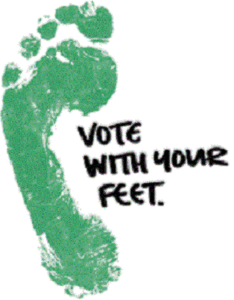

On Labor Day last year and in 2021, I wrote posts explaining how breaking down barriers to labor mobility can help many millions of workers around the world. Virtually everything in last year’s post is just as relevant today. So I am reprinting it with some updates and modifications:
Today is Labor Day. As usual, there is much discussion of what can be done to help workers. But few focus on the one type of reform that is likely to help more poor and disadvantaged workers than virtually anything else: increasing labor mobility. In the United States and around the world, far too many workers are trapped in places where it is difficult or impossible for them to ever escape poverty. They could better their lot if allowed to “vote with their feet” by moving to locations where there are better job opportunities. That would also be an enormous boon to the rest of society.
Internationally, the biggest barriers condemning millions to lives of poverty and oppression are immigration restrictions. Economists estimate that eliminating legal barriers to migration throughout the world would roughly double world GDP—in other words, making the world twice as productive as it is now. A person who has the misfortune of being born in Cuba or Venezuela, Zimbabwe or Afghanistan, is likely condemned to lifelong poverty, no matter how talented or hardworking he or she may be. If he is allowed to move to a freer society with better economic institutions, he can almost immediately double or triple his income and productivity. And that doesn’t consider the possibility of improving his job skills, which is also likely to be more feasible in his new home than in his country of origin.
The vast new wealth created by breaking down migration barriers would obviously benefit migrants themselves. But it also creates enormous advantages for receiving-country natives, as well. They benefit from cheaper and better products, increased innovation, and the establishment of new businesses (which immigrants create at higher rates than natives). Immigrants also contribute disproportionately to scientific and medical innovation, such as the MRNA Covid-19 vaccines, that have already saved many thousands of lives around the world.
Similar, though somewhat less extreme, barriers to labor mobility also harm workers within the United States. Exclusionary zoning prevents many millions of Americans—particularly the poor and working class—from moving to areas where they could find better job opportunities and thereby increase their wages and standard of living. Recent evidence suggests that the problem is even worse than scholars previously thought. Occupational licensing further exacerbates the problem, by making it difficult for workers in many industries to move from one state to another.
Breaking down barriers to labor mobility is an oft-ignored common interest of poor minorities (most of whom are Democrats), and the increasingly Republican white working class. Both groups could benefit from increased opportunity to move to places where there are more and better jobs and educational opportunities available.
As with lowering immigration restrictions, breaking down domestic barriers to labor mobility would create enormous benefits for society as a whole, as well as the migrants themselves. Economists estimate that cutting back on exclusionary zoning would greatly increase economic growth. Like international migrants, domestic ones can be more productive and innovative if given the opportunity to move to places where they can make better use of their talents.
Many proposals to help workers have a zero-sum quality. They involve attempts to forcibly redistribute wealth from employers, investors, consumers, or some combination of all three. Given that virtually all workers are also consumers, and many also have investments (e.g.—through their retirement accounts), zero-sum policies that help them in one capacity often harm them in another. Breaking down barriers to labor mobility, by contrast, is a positive-sum game that creates massive benefits for both workers and society as a whole; it similarly benefits both migrants and natives.
Some on the left point out that, if investors are allowed to move capital freely, workers should be equally free to move, as well. It is indeed true that, thanks to government policies restricting labor mobility, investment capital is generally more mobile than labor. It is also true that the restrictions on labor mobility are deeply unjust. In many cases, they trap people in poverty simply because of arbitrary circumstances of birth, much as racial segregation and feudalism once did. The inequality between labor and capital, and the parallels with segregation and feudalism should lead progressives to put a higher priority on increasing labor mobility.
At the same time, it is worth recognizin, that investors and employers, as a class, are likely to benefit from increased labor mobility, too. Increased productivity and innovation create new investment opportunities. The biggest enemies of both workers and capitalists are not each other, but the combination of nativists and NIMBYs who erect barriers to freedom of movement, thereby needlessly impoverishing labor and capital alike. Despite conventional wisdom to the contrary, even current homeowners often have much to gain from curbing exclusionary zoning policies that block the construction of housing needed by workers seeking to move to the region.
On the right, conservatives who value meritocracy and reject racial and ethnic preferences, would do well to recognize that few policies are so anti-meritocratic as barriers to mobility. The case for ending them also has much in common with the case for color-blind government policies, more generally. A number of other conservative values also reinforce the case for curbing both domestic NIMBYism and immigration restrictions.
Obviously, there are those who argue against increasing labor mobility, either on the grounds that existing communities have an inherent right to exclude newcomers, or because allowing them to come would have various negative side-effects. I address these types of arguments here, and in much greater detail in Chapters 5 and 6 of my book Free to Move: Foot Voting, Migration, and Political Freedom. As I explain in those earlier publications, nearly all such objections are wrong, overblown, or can be ameliorated by “keyhole solutions” that are less draconian than exclusion. In addition, the vast new wealth created by breaking down barriers to mobility can itself be used to help address any potential negative effects. In the book, I also push back against claims that mobility should be restricted for the benefit of those “left behind” in migrants’ communities of origin.
In recent years, there has been important progress on both expanding immigration and reducing exclusionary zoning. Several states have also enacted occupational licensing reform, which facilitates freedom of movement between states. But there is much room for further progress on all these fronts.
Workers of the world, unite to demand more freedom of movement!
The post Help Workers by Breaking Down Barriers to Labor Mobility—Both Domestic and International appeared first on Reason.com.
from Latest https://ift.tt/nypzu9s
via IFTTT